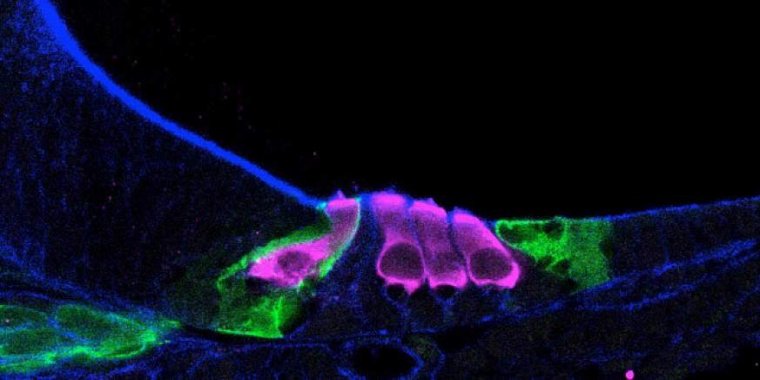| Health / Health News |
Study charts developmental map of inner ear sound sensor in mice
A team of researchers has generated a developmental map of a key sound-sensing structure in the mouse inner ear.

Single-cell RNA sequencing helped scientists map how sensory hair cells (pink) develop in a newborn mouse cochlea. Photo: Helen Maunsell, NIDCD/NIH.
Scientists at the National Institute on Deafness and Other Communication Disorders (NIDCD), part of the National Institutes of Health, and their collaborators analyzed data from 30,000 cells from mouse cochlea, the snail-shaped structure of the inner ear.
The results provide insights into the genetic programs that drive the formation of cells important for detecting sounds.
The study also sheds light specifically on the underlying cause of hearing loss linked to Ehlers-Danlos syndrome and Loeys-Dietz syndrome.
The research team includes investigators at the University of Maryland School of Medicine, Baltimore; Decibel Therapeutics, Boston; and King’s College London.
“Unlike many other types of cells in the body, the sensory cells that enable us to hear do not have the capacity to regenerate when they become damaged or diseased,” said NIDCD Director Debara L. Tucci, M.D., who is also an otolaryngology-head and neck surgeon.
“By clarifying our understanding of how these cells are formed in the developing inner ear, this work is an important asset for scientists working on stem cell-based therapeutics that may treat or reverse some forms of inner ear hearing loss.”
In mammals, the primary transducers of sound are hair cells, which are spread across a thin ribbon of tissue (the organ of Corti) that runs the length of the coiled cochlea.
There are two kinds of hair cells, inner hair cells and outer hair cells, and they are structurally and functionally sustained by several types of supporting cells.
During development, a pool of nearly identical progenitor cells gives rise to these different cell types, but the factors that guide the transformation of progenitors into hair cells are not fully understood.
To learn more about how the cochlea forms, Kelley’s team took advantage of a method called single-cell RNA sequencing. This powerful technique enables researchers to analyze the gene activity patterns of single cells.
“There are only a few thousand hair cells in the cochlea, and they are arrayed close together in a complex mosaic, an arrangement that makes the cells hard to isolate and characterize,” said Kelley. “Single-cell RNA sequencing has provided us with a valuable tool to track individual cells’ behaviors as they take their places in the intricate structure of the developing cochlea.”
Kelley’s team focused on one gene, Tgfbr1, which has been linked to two conditions associated with hearing loss, Ehlers-Danlos syndrome and Loeys-Dietz syndrome.
The data showed that Tgfbr1 is active in outer hair cell precursors as early as the 14th day of embryonic development, suggesting that the gene is important for initiating the formation of these cells.
To explore Tgfbr1’s role, the researchers blocked the Tgfbr1 protein’s activity in cochleae from 14.5-day-old mouse embryos.
When they examined the cochleae five days later, they saw fewer outer hair cells compared to the embryonic mouse cochleae that had not been treated with the Tgfbr1 blocker.
This finding suggests that hearing loss in people with Tgfbr1 mutations could stem from impaired outer hair cell formation during development.
The study revealed additional insights into the early stages of cochlear development. The developmental pathways of inner and outer hair cells diverge early on; researchers observed distinct gene activity patterns at the earliest time point in the study, the 14th day of embryonic development.
This suggests that the precursors from which these cells derive are not as uniform as previously believed. (National Institutes of Health)
YOU MAY ALSO LIKE





